Topics
Category
Era
Wild Rice and the Ojibwe
Citizens of the Leech Lake Band of Ojibwe harvest rice on Mud Lake, located on the Leech River, seventeen miles downstream of Leech Lake Dam, on September 3, 2015. USACE photo by George Stringham. Public domain.
Wild rice is a food of great historical, spiritual, and cultural importance for Ojibwe people. After colonization disrupted their traditional food system, however, they could no longer depend on stores of wild rice for food all year round. In the late 1950s and early 1960s, this traditional staple was appropriated by white entrepreneurs and marketed as a gourmet commodity. Native and non-Native people alike began to harvest rice to sell it for cash, threatening the health of the natural stands of the crop. This lucrative market paved the way for domestication of the plant, and farmers began cultivating it in paddies in the late 1960s. In the twenty-first century, many Ojibwe and other Native people are fighting to sustain the hand-harvested wild rice tradition and to protect wild rice beds.
Ojibwe people arrived in present-day Minnesota in the 1600s after a long migration from the east coast of the United States that lasted many centuries. Together with their Anishinaabe kin, the Potawatomi and Odawa, they followed a vision that told them to search for their homeland in a place “where the food floats on water.” The Ojibwe recognized this as the wild rice they found growing around Lake Superior (Gichigami), and they settled on the sacred site of what is known today as Madeline Island (Mooningwaanekaaning).
In the Ojibwe language, wild rice (Zizania palustris) is called manoomin, which is related by analogy to a word (minomin) meaning 'good berry.'” It is a highly nutritious wild grain that is gathered from lakes and waterways by canoe in late August and early September, during the wild rice moon (manoominike giizis).
Before contact with Europeans and as late as the early twentieth century, Ojibwe people depended on wild rice as a crucial part of their diet, together with berries, fish, meat, vegetables, and maple sugar. They moved their camps throughout the year, depending on the activities of seasonal food gathering. In autumn, families moved to a location close to a lake with a promising stand of wild rice and stayed there for the duration of the season. Men hunted and fished while women harvested rice, preparing food for their families to eat throughout the following winter, spring, and summer.
TRADITIONAL HARVESTING METHODS
Ojibwe people harvested wild rice, and continue to harvest it today, in pairs, with one person pushing or paddling a canoe and the other knocking rice into it with sticks (bawa'iganaakoog). When the wild rice is ripe, the grains fall easily into a canoe, and the grains that fall into the water lodge themselves into the mud, then grow into the following year’s stands of rice.
Freshly harvested manoomin is called “green” rice. When processed in the traditional way, it is parched (roasted) over a fire, then threshed by being stepped or danced on. This motion, called jigging, loosens and removes the fibrous outer covering of the grain. Finally, to separate the hulls from the grain, wild rice is “winnowed” or “fanned”—tossed up in the air with birch bark trays (nooshkaachinaaganan) so that the hulls are blown away and only the edible grain is left behind.
The work that goes into preparing wild rice for eating and storage was traditionally carried out collectively. Women marked the areas designated for particular families by binding a number of heads together. This ensured that everyone in the community got the rice they needed, and it also made harvesting easier.
Taking care of the natural world that sustains us forms a central part of the Ojibwe people’s way of seeing the world. Traditional wild rice harvesting practices reflect this, protecting wild rice beds for the long-term wellbeing of the ecosystem as well as the community. Designated elders would, and on reservations still do, carefully monitor lakes to prevent premature or excessive harvests, “opening” and “closing” lakes to ricing as necessary, and leaving some mature grains unharvested for re-seeding.
LOSS OF A TRADITIONAL FOOD SYSTEM
As far back as the early fur trade in the mid-1600s, some Ojibwe families traded wild rice for goods. For the most part, however, they collected it for household consumption or trade between tribes. Processing wild rice is a labor-intensive activity, and families harvested only as much as they could process.
Colonization, land loss, the establishment of reservations, and dependence on government food and payments separated Ojibwe people from their way of life and—with some exceptions—threatened their traditional food system. As people stopped eating their traditional diets in the mid-twentieth century, major health problems like diabetes emerged. Harvesting practices also changed as they lost access to the lakes and rivers in which wild rice grew, and as they adapted to the changing world around them. Men began to harvest wild rice together with women, gathering it in aluminum canoes rather than birch bark ones and processing it with machines. Until the 1950s, Ojibwe people remained the primary ricers.
Ojibwe people both on and off reservations faced a period of difficulty after World War II. Traditional lifeways could no longer sustain family needs, and jobs were difficult to find. Many people moved to cities; others suffered from poverty on their reservations. At the same time, the North American wild rice market shifted as a new marketing model began to demand products in large quantities to be sold across the nation. The price of wild rice rose as it gained in popularity, and both Natives and non-Natives began to harvest the crop for cash rather than for home consumption. Inexperienced non-Native harvesters used methods that began to put wild rice beds in danger. Technology, including parching, thrashing, and fanning machines, was further developed to process the rice with more ease. Processing plants were set up across the state—primarily, but not exclusively, by white people.
As the national market for wild rice grew, more people became interested in figuring out how to cultivate it as a crop, like paddy rice. This led to domestication efforts at the University of Minnesota and the expansion of many acres of paddy rice in both Minnesota and California. Wild rice was made the Minnesota state grain in 1977. Unfortunately, however, the cheaper production costs of cultivated wild rice drove down demand for hand-harvested wild rice, leaving Ojibwe people without this source of income.
RESTORATION AND REGULATION
As far back as the 1930s, the health of wild rice beds has been a serious concern. In 1939 Minnesota passed a law outlawing mechanized harvest and limiting how and when wild rice could be harvested. Since then, it has enacted other protective policies, including limiting the number of hours in the day during which it is permissible to rice and limiting the length of the canoe used for ricing. In the 1990s, wild rice was identified as an endangered food. The plant is sensitive to water levels altered by dams as well as road construction, pollution, poor harvesting practices, invasive species, genetic engineering (genetic contamination of the wild rice from the paddies), and climate change.
In response to these threats, Ojibwe and other Native people organized. For example, in 1994, the Fond du Lac and Bois Forte bands developed a “Wild Rice Restoration Plan for the St. Louis River Watershed” designed to restore lost stands of the crop and manage its harvest. In the same decade, the company Native Harvest (part of the White Earth Land Recovery Project) began to sell hand-harvested wild rice, and multiple bands formed reservation wild-rice committees to manage harvests.
In the 2020s, Ojibwe people continue to defend and protect this vital plant and the cultural, health, and spiritual importance that it holds. Individuals as well as tribes organize ricing camps to teach traditional practices of ricing, parching, and finishing. Others are actively fighting against the Enbridge Line 3 oil pipeline replacement project that would cross wild rice habitat, or collaborating in a movement for Native food sovereignty.
Bibliography
Anderson, R. A. "Wild Rice: Nutritional Review." Cereal Chemistry 53, no. 6 (1976): 949–955.
https://www.cerealsgrains.org/publications/cc/backissues/1976/Documents/Chem53_949.pdf
Bouayad, Aurelien. "Wild Rice Protectors: An Ojibwe Odyssey." Environmental Law Review 22, no. 1 (2020): 25–42.
Boyd, Li. “Will the Real Wild Rice Please Stand up?” Ojibwe Inaajimowin 1806 (June 2018): 5.
https://static1.squarespace.com/static/60706724c6db8135873009c4/t/60e4c1937cdadd56b5ad81ca/1625604503969/1806-inaajimowin.pdf
Buffalohead, Priscilla K. "Farmers, Warriors, Traders: A Fresh Look at Ojibway Women." Minnesota History 48, no. 6: (Summer 1983): 236–244.
http://collections.mnhs.org/MNHistoryMagazine/articles/48/v48i06p236-244.pdf
Cheruvelil, Jubin J., and Barbara Barton. “Wild Rice Adaptation to Climate Change.” Report submitted to Freshwater Futures, January 2013.
https://www.researchgate.net/publication/260573079_Wild_Rice_Adaptation_to_Climate_Change
Child, Brenda J. Holding Our World Together: Ojibwe Women and the Survival of Community. New York: Penguin Books, 2013.
——— . My Grandfather’s Knocking Sticks: Ojibwe Family Life and Labor on the Reservation. St. Paul: Minnesota Historical Society Press, 2014.
Coleman, Bernard. "The Ojibwa and the Wild Rice Problem." Anthropological Quarterly 26, no. 3 (July 1953): 79–88.
Drewes, Annette D., and Janet Silbernagel. "Uncovering the Spatial Dynamics of Wild Rice Lakes, Harvesters and Management Across Great Lakes Landscapes for Shared Regional Conservation." Ecological Modeling 229 (2012): 97–107.
Fond du Lac Band of Lake Superior Chippewa. “Testimony to the House Subcommittee on Appropriations for Agriculture, FY-1996.” In Agriculture, Rural Development, Food and Drug Administration, and Related Agencies Appropriations for 1996 (Washington, DC: US Government Printing Office, 1995).
https://books.google.com/books?id=oxQMF6NyZ_YC&pg
Hayes, P. M., R. E. Stucker, and G. G. Wandrey. "The Domestication of American Wild Rice (Zizania palustris, Poaceae)." Economic Botany 43, no. 2 (April 1989): 203–214.
Hoover, Elizabeth M. "Wild Rice: Spirit Lake Native Farms, Fon [sic] du Lac Reservation." From Garden Warriors to Good Seeds: Indigenizing the Local Food Movement, January 27, 2015.
https://gardenwarriorsgoodseeds.com/2015/01/27/wild-rice-spirit-lake-native-farms-fon-du-lac-reservation-mn-2
——— . "Honor the Earth, Pipeline Ride, Saving Minnesota’s Water and Wild Rice." From Garden Warriors to Good Seeds: Indigenizing the Local Food Movement, February 2, 2015.
Jenks, Albert E. The Wild Rice Gatherers of the Upper Lakes: A Study in American Primitive Economics. Washington, DC: Government Printing Office, 1901.
https://archive.org/details/wildricegatherer00jenk/page/n8
Kappler, Charles J., comp. and ed. "Treaty with the Chippewa, 1842." In Indian Affairs: Laws and Treaties (Washington, DC: Government Printing Office, 1904): 542–548.
LaDuke, Winona. "Wild Rice: Maps, Genes, and Patents." Institute for Agriculture & Trade Policy, September 7, 2001.
https://www.iatp.org/documents/wild-rice-maps-genes-and-patents
——— . "Ricekeepers: A Struggle to Protect Biodiversity and a Native American Way of Life." Orion 26 (2007): 18–23.
——— . "Protecting the Culture and Genetics of Wild Rice." In Original Instructions: Indigenous Teachings for A Sustainable Future, Melissa Nelson, ed. (Rochester, VT: Bear, 2008): 206–214.
——— . "The Long and Honorable Battle of the Ojibwe to Keep Their Wild Rice Wild." Indian Country Today Media Network, November 2, 2011.
https://indiancountrytoday.com/archive/the-long-and-honorable-battle-of-the-ojibwe-to-keep-their-wild-rice-wild-_dXm7kHqx0-l82Fu2arYLg
Moodie, D. Wayne. "Manomin: Historical-Geographical Perspectives on the Ojibwa Production of Wild Rice." In Aboriginal Resource Use in Canada: Historical and Legal Aspects, Kerry Abel and Jean Friesen, eds. (Winnipeg: University of Manitoba Press, 1991): 71–79.
Raster, Amanda, and Christina Gish Hill. "The Dispute Over Wild Rice: An Investigation of Treaty Agreements and Ojibwe Food Sovereignty." Agriculture and Human Values 34, no. 2 (June 2017): 267–281.
Smith, Kelly. “In Tribes Across Minnesota, Indigenous Food Movement Takes Root.” Minneapolis Star Tribune, July 22, 2018.
Vennum Jr., Thomas. Wild Rice and the Ojibway People. St. Paul: Minnesota Historical Society Press, 1988.
Walker, Rachel K., and Jill Doerfler. "Wild Rice: The Minnesota Legislature, A Distinctive Crop, GMOs, and Ojibwe Perspectives." Hamline Law Review 32 (2009):499–527.
https://conservancy.umn.edu/handle/11299/189319
Related Resources
Secondary
McClurken, James M., et al. Fish in the Lakes, Wild Rice, and Game in Abundance: Testimony on Behalf of Mille Lacs Ojibwe Hunting and Fishing Rights. East Lansing, MI: Michigan State University Press, 2000.
Web
“How to Harvest Wild Rice!” YouTube video, 9:47. Posted by WIDNRTV, December 7, 2015.
https://www.youtube.com/watch?v=wCQfVYiRpsA
Manoomin: Food That Grows on the Water. Great Lakes Native Culture & Language.
https://theways.org/story/manoomin.html
“MN Traditions - Wild Rice Harvesting.” YouTube video, 4:52. Posted by Minnesota Traditions, March 2, 2018.
https://www.youtube.com/watch?v=O50VrGfgndE
“Harvesting Wild Rice with Sagkeeng Child and Family Services – 2012.” YouTube video, 7:06. Posted by SagkeengCFS, July 30, 2013.
https://www.youtube.com/watch?v=2L2DijK6xJ4
Wild Rice History, Biology and Harvest. University Place. PBS Wisconsin.
https://wpt4.org/wpt-video/university-place/university-place-wild-rice-history-biology-and-harvest
“Wild Rice: The Taming of a Grain (Waterstone Films, 1987).” YouTube video, 18:06. Posted by alleye 23, February 12, 2005.
https://www.youtube.com/watch?v=KBPavBGBqjM
Related Video
Wild Rice Harvesting
Manoomin or psin (wild rice in Ojibwe and Dakota) is an important traditional food for many Indigenous peoples of the region and has been for millennia. Join Pat and Gage Kruse (Red Cliff Band of Lake Superior Chippewa) as they go ricing and share harvesting techniques and other information related to wild rice.
More Information
Articles
Wild Rice Processing: Threshing
A demonstration of how to thresh wild rice, September 1, 2021.
More Information
Articles
Related Images
Mortar and pestle used by Ojibwe people for threshing wild rice. The long pestle (A) is made from a roughly carved piece of wood. The mortar (B) is a cedar slat bucket with a round log slab base. Because the support hoops are not attached, the mortar disassembles easily for storage. Forms part of the Jeannette O. and Harry D. Ayer Ojibwe Collection.
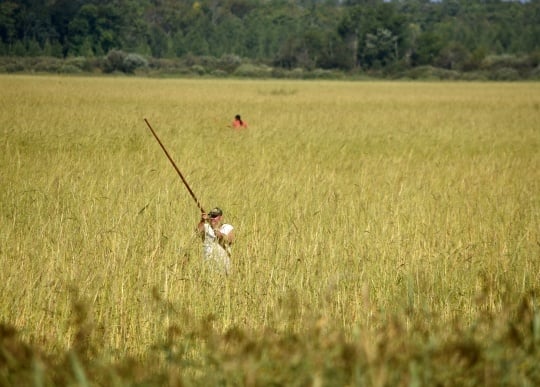
Wild rice harvest on Mud Lake
Citizens of the Leech Lake Band of Ojibwe harvest rice on Mud Lake, located on the Leech River, seventeen miles downstream of Leech Lake Dam, on September 3, 2015. USACE photo by George Stringham. Public domain.
Holding Location
Articles

Ancient ceramic vessel with evidence of wild rice
St. Croix stamped ceramic vessel containing evidence of wild rice. Created by Native people who lived in the Upper Mississippi region before 640 CE.
Holding Location
Articles
More Information
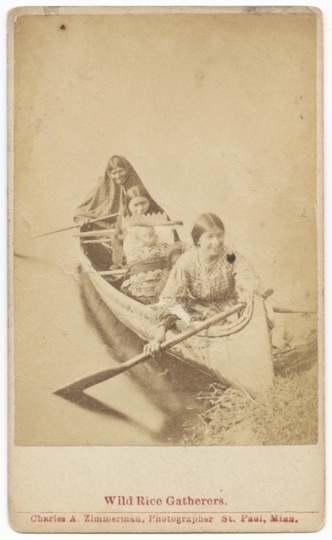
Ojibwe women harvesting wild rice
Ojibwe women harvesting wild rice, ca. 1885. Photograph by Charles A. Zimmerman.
Public domain
Holding Location
More Information
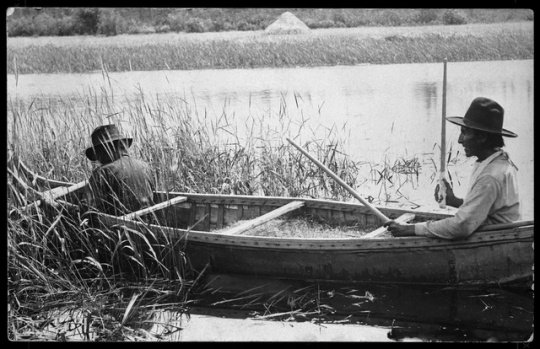
Men harvesting wild rice
Ojibwe men in a canoe harvesting wild rice, ca. 1915.
Holding Location
More Information
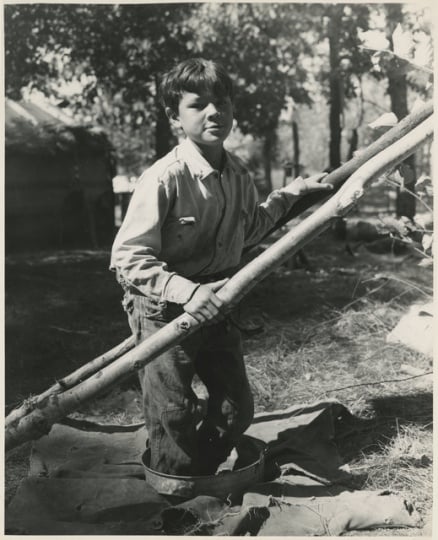
Boy treading wild rice
An Ojibwe boy treading wild rice, ca. 1938.
Holding Location
Articles
More Information
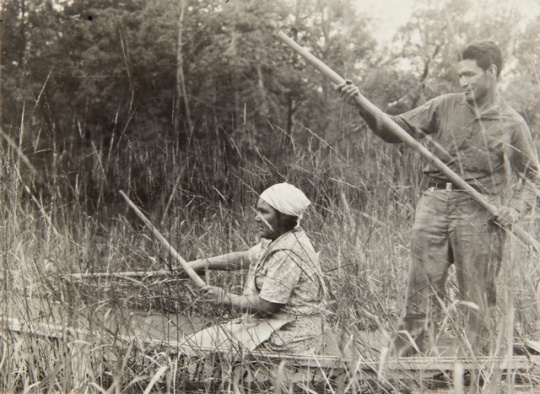
Harvesting wild rice
Ojibwe harvesting wild rice. Photograph by Monroe P. Killy, 1939.
Holding Location
More Information
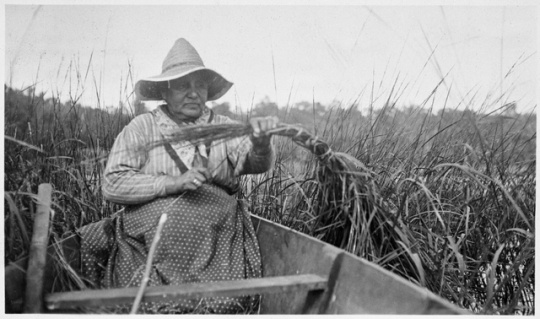
Tying wild rice stalks
An Ojibwe woman ties together stalks of wild rice with basswood fiber to prepare them for harvest. Photograph by Frances Densmore, ca. 1930s. From Reserve Album 96, page 27.
Holding Location
Articles
More Information
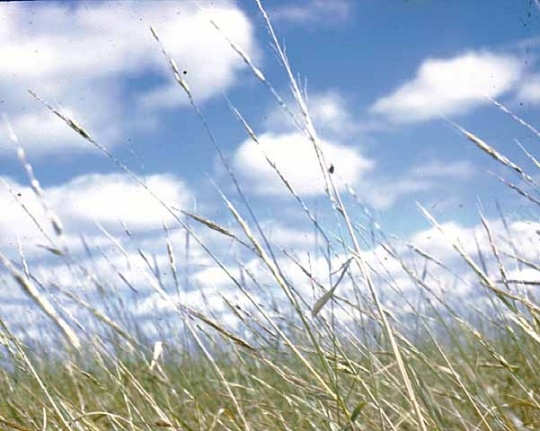
Wild rice growing at Nett Lake
Wild rice growing at Nett Lake. Photograph by Monroe P. Killy, September 1, 1946. Minnesota Historical Society, Collection I.69.121.
Holding Location
Articles
More Information
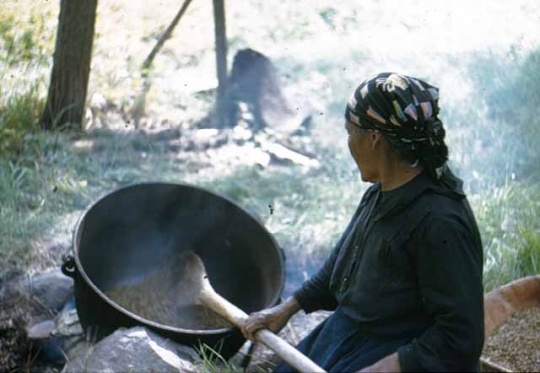
Parching wild rice at Nett Lake
Bebaa migizi go gaa (Mrs. Peter Fields) uses a traditional Ojibwe method to parch wild rice at Nett Lake. Photograph by Monroe P. Killy, September 1, 1946.
Holding Location
Articles
More Information
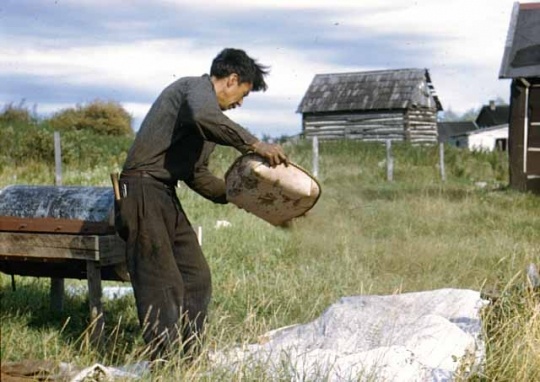
Jim Drift winnowing wild rice at Nett Lake
Jim Drift winnowing wild rice at Nett Lake. Photograph by Monroe P. Killy, September 1, 1946.
Holding Location
Articles
More Information
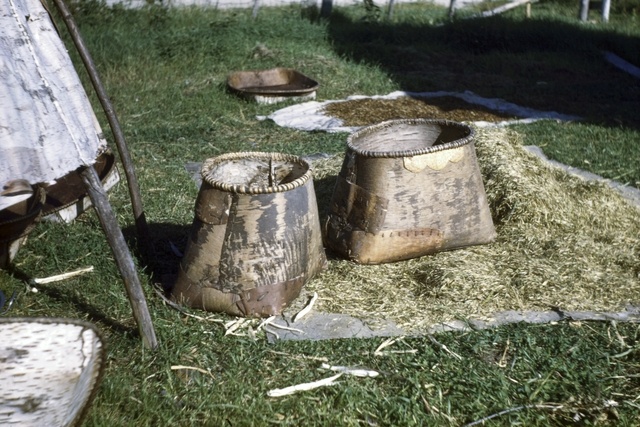
Drying wild rice at Nett Lake
Drying wild rice at Nett Lake. Photograph by Monroe P. Killy, September 6, 1947.
Holding Location
Articles
More Information
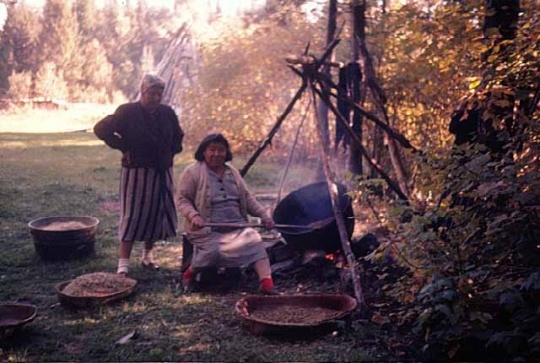
Women parching wild rice at Nett Lake
Ojibwe women parching wild rice at Nett Lake Indian Reservation, ca. 1947. Photograph by Monroe P. Killy.
Holding Location
Articles
More Information
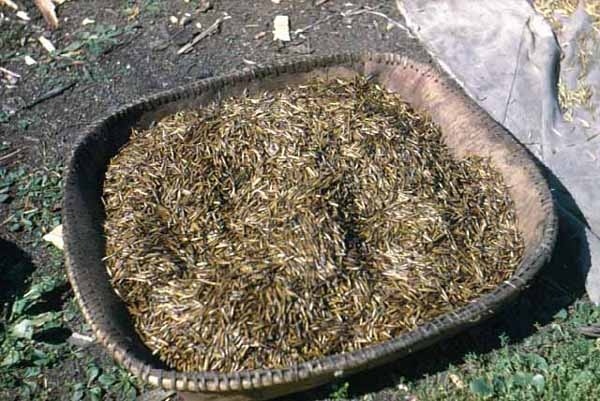
Parched wild rice
Parched wild rice at Nett Lake. Photograph by Monroe P. Killy, September 6, 1947.
Holding Location
Articles
More Information

Mortar and pestle for threshing wild rice
Mortar and pestle used by Ojibwe people for threshing wild rice. The long pestle (A) is made from a roughly carved piece of wood. The mortar (B) is a cedar slat bucket with a round log slab base. Because the support hoops are not attached, the mortar disassembles easily for storage. Forms part of the Jeannette O. and Harry D. Ayer Ojibwe Collection.
Holding Location
Articles
More Information
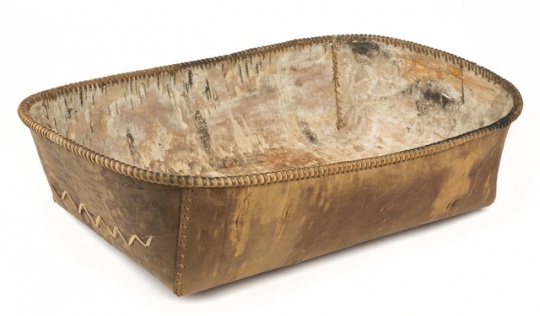
Ojibwe birchbark winnowing basket
Ojibwe birchbark winnowing basket, created not later than 1930. Used at Grand Portage Indian Reservation.
Holding Location
Articles
More Information

Bawa'iganaakoog (ricing sticks)
Pair of bawa'iganaakoog (ricing sticks or knockers) wrapped with cloth tape. Made and used by Robert Gawboy Jr. (Bois Forte Band of Chippewa) between 1940 and 1960.
Holding Location
Articles
More Information
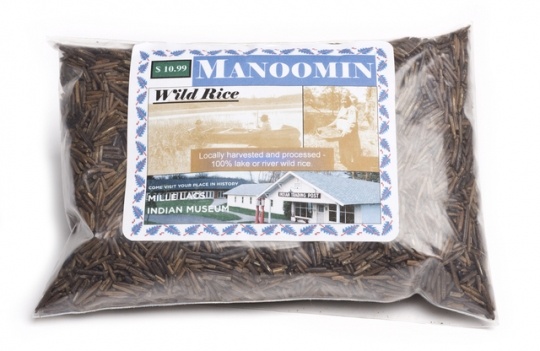
Manoomin (wild rice) from Mille Lacs
Manoomin (wild rice) sold at Mille Lacs Indian Museum. Packed in 2004 by Manoomin, Inc., of McGregor, Minnesota, a company owned by members of the Mille Lacs Band of Ojibwe.
Holding Location
Articles
More Information
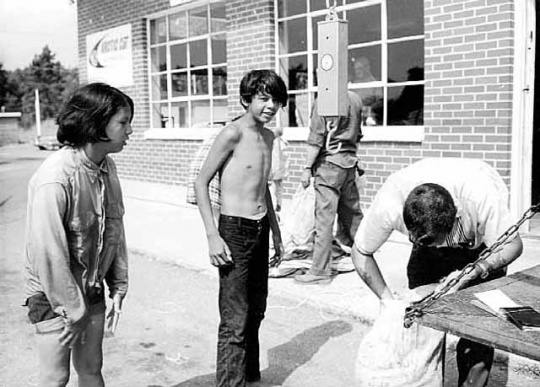
Wild rice buyer and sellers
Two Ojibwe youths sell bags of wild rice to a buyer on the Leech Lake Reservation of Ojibwe. Photograph by Bill Burnson, ca. 1970.
Holding Location
More Information
Related Articles
Turning Point
In 1837, when the Treaty of Mendota claims Ojibwe land for the United States, a period of dispossession of Ojibwe people from their land begins that disrupts their traditional food system.
Chronology
ca. 1400
1600s
1837
1854
1930s
mid-1930s
1939
1950
1950s
1961
1965
1968
1989
1990s
1994
1999
Bibliography
Anderson, R. A. "Wild Rice: Nutritional Review." Cereal Chemistry 53, no. 6 (1976): 949–955.
https://www.cerealsgrains.org/publications/cc/backissues/1976/Documents/Chem53_949.pdf
Bouayad, Aurelien. "Wild Rice Protectors: An Ojibwe Odyssey." Environmental Law Review 22, no. 1 (2020): 25–42.
Boyd, Li. “Will the Real Wild Rice Please Stand up?” Ojibwe Inaajimowin 1806 (June 2018): 5.
https://static1.squarespace.com/static/60706724c6db8135873009c4/t/60e4c1937cdadd56b5ad81ca/1625604503969/1806-inaajimowin.pdf
Buffalohead, Priscilla K. "Farmers, Warriors, Traders: A Fresh Look at Ojibway Women." Minnesota History 48, no. 6: (Summer 1983): 236–244.
http://collections.mnhs.org/MNHistoryMagazine/articles/48/v48i06p236-244.pdf
Cheruvelil, Jubin J., and Barbara Barton. “Wild Rice Adaptation to Climate Change.” Report submitted to Freshwater Futures, January 2013.
https://www.researchgate.net/publication/260573079_Wild_Rice_Adaptation_to_Climate_Change
Child, Brenda J. Holding Our World Together: Ojibwe Women and the Survival of Community. New York: Penguin Books, 2013.
——— . My Grandfather’s Knocking Sticks: Ojibwe Family Life and Labor on the Reservation. St. Paul: Minnesota Historical Society Press, 2014.
Coleman, Bernard. "The Ojibwa and the Wild Rice Problem." Anthropological Quarterly 26, no. 3 (July 1953): 79–88.
Drewes, Annette D., and Janet Silbernagel. "Uncovering the Spatial Dynamics of Wild Rice Lakes, Harvesters and Management Across Great Lakes Landscapes for Shared Regional Conservation." Ecological Modeling 229 (2012): 97–107.
Fond du Lac Band of Lake Superior Chippewa. “Testimony to the House Subcommittee on Appropriations for Agriculture, FY-1996.” In Agriculture, Rural Development, Food and Drug Administration, and Related Agencies Appropriations for 1996 (Washington, DC: US Government Printing Office, 1995).
https://books.google.com/books?id=oxQMF6NyZ_YC&pg
Hayes, P. M., R. E. Stucker, and G. G. Wandrey. "The Domestication of American Wild Rice (Zizania palustris, Poaceae)." Economic Botany 43, no. 2 (April 1989): 203–214.
Hoover, Elizabeth M. "Wild Rice: Spirit Lake Native Farms, Fon [sic] du Lac Reservation." From Garden Warriors to Good Seeds: Indigenizing the Local Food Movement, January 27, 2015.
https://gardenwarriorsgoodseeds.com/2015/01/27/wild-rice-spirit-lake-native-farms-fon-du-lac-reservation-mn-2
——— . "Honor the Earth, Pipeline Ride, Saving Minnesota’s Water and Wild Rice." From Garden Warriors to Good Seeds: Indigenizing the Local Food Movement, February 2, 2015.
Jenks, Albert E. The Wild Rice Gatherers of the Upper Lakes: A Study in American Primitive Economics. Washington, DC: Government Printing Office, 1901.
https://archive.org/details/wildricegatherer00jenk/page/n8
Kappler, Charles J., comp. and ed. "Treaty with the Chippewa, 1842." In Indian Affairs: Laws and Treaties (Washington, DC: Government Printing Office, 1904): 542–548.
LaDuke, Winona. "Wild Rice: Maps, Genes, and Patents." Institute for Agriculture & Trade Policy, September 7, 2001.
https://www.iatp.org/documents/wild-rice-maps-genes-and-patents
——— . "Ricekeepers: A Struggle to Protect Biodiversity and a Native American Way of Life." Orion 26 (2007): 18–23.
——— . "Protecting the Culture and Genetics of Wild Rice." In Original Instructions: Indigenous Teachings for A Sustainable Future, Melissa Nelson, ed. (Rochester, VT: Bear, 2008): 206–214.
——— . "The Long and Honorable Battle of the Ojibwe to Keep Their Wild Rice Wild." Indian Country Today Media Network, November 2, 2011.
https://indiancountrytoday.com/archive/the-long-and-honorable-battle-of-the-ojibwe-to-keep-their-wild-rice-wild-_dXm7kHqx0-l82Fu2arYLg
Moodie, D. Wayne. "Manomin: Historical-Geographical Perspectives on the Ojibwa Production of Wild Rice." In Aboriginal Resource Use in Canada: Historical and Legal Aspects, Kerry Abel and Jean Friesen, eds. (Winnipeg: University of Manitoba Press, 1991): 71–79.
Raster, Amanda, and Christina Gish Hill. "The Dispute Over Wild Rice: An Investigation of Treaty Agreements and Ojibwe Food Sovereignty." Agriculture and Human Values 34, no. 2 (June 2017): 267–281.
Smith, Kelly. “In Tribes Across Minnesota, Indigenous Food Movement Takes Root.” Minneapolis Star Tribune, July 22, 2018.
Vennum Jr., Thomas. Wild Rice and the Ojibway People. St. Paul: Minnesota Historical Society Press, 1988.
Walker, Rachel K., and Jill Doerfler. "Wild Rice: The Minnesota Legislature, A Distinctive Crop, GMOs, and Ojibwe Perspectives." Hamline Law Review 32 (2009):499–527.
https://conservancy.umn.edu/handle/11299/189319
Related Resources
Secondary
McClurken, James M., et al. Fish in the Lakes, Wild Rice, and Game in Abundance: Testimony on Behalf of Mille Lacs Ojibwe Hunting and Fishing Rights. East Lansing, MI: Michigan State University Press, 2000.
Web
“How to Harvest Wild Rice!” YouTube video, 9:47. Posted by WIDNRTV, December 7, 2015.
https://www.youtube.com/watch?v=wCQfVYiRpsA
Manoomin: Food That Grows on the Water. Great Lakes Native Culture & Language.
https://theways.org/story/manoomin.html
“MN Traditions - Wild Rice Harvesting.” YouTube video, 4:52. Posted by Minnesota Traditions, March 2, 2018.
https://www.youtube.com/watch?v=O50VrGfgndE
“Harvesting Wild Rice with Sagkeeng Child and Family Services – 2012.” YouTube video, 7:06. Posted by SagkeengCFS, July 30, 2013.
https://www.youtube.com/watch?v=2L2DijK6xJ4
Wild Rice History, Biology and Harvest. University Place. PBS Wisconsin.
https://wpt4.org/wpt-video/university-place/university-place-wild-rice-history-biology-and-harvest
“Wild Rice: The Taming of a Grain (Waterstone Films, 1987).” YouTube video, 18:06. Posted by alleye 23, February 12, 2005.
https://www.youtube.com/watch?v=KBPavBGBqjM





















